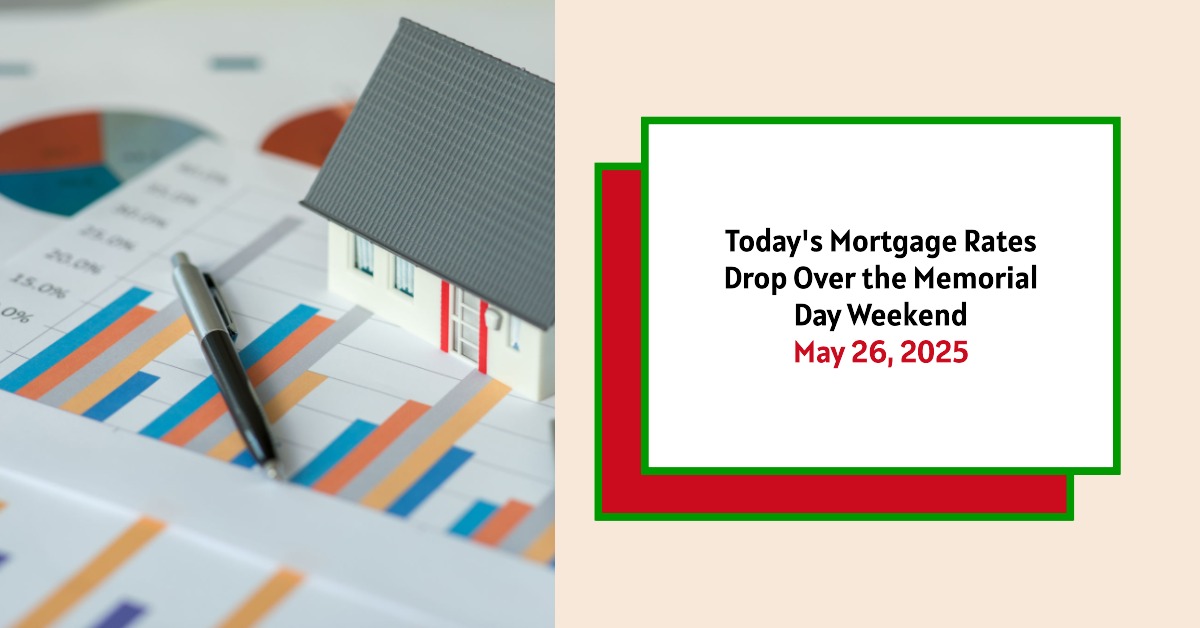Today's mortgage rates have seen a slight decrease. As of May 26, 2025, the average 30-year fixed mortgage rate is 6.89%, a drop of three basis points. On the other hand, the 15-year fixed mortgage rate has increased by one basis point, now standing at 6.11%. This fluctuation in interest rates reflects changes in retail mortgage rate demand, especially with the bond market being closed over the Memorial Day weekend. The bond market's reopening later this week may bring further developments in these rates as it reacts to ongoing economic concerns, including the national debt and tariffs affecting the U.S. economy.
Today's Mortgage Rates – May 26, 2025: Rates Drop Slightly Over the Memorial Day Weekend
Key Takeaways
- 30-year fixed: Decreased to 6.89%
- 15-year fixed: Increased to 6.11%
- Bond Market: Closed for Memorial Day, influencing slight rate fluctuations
- Investor Concerns: Higher national debt and tariffs affect bond yields
- Refinance Rates: Slightly higher compared to purchasing rates
Mortgage Rates Today
In examining the current mortgage rates, according to Zillow data, we can break down the national averages as follows:
| Loan Type | Interest Rate (%) |
|---|---|
| 30-Year Fixed | 6.89% |
| 20-Year Fixed | 6.62% |
| 15-Year Fixed | 6.11% |
| 5/1 Adjustable Rate | 6.89% |
| 7/1 Adjustable Rate | 7.16% |
| 30-Year VA | 6.50% |
| 15-Year VA | 5.94% |
| 5/1 VA | 6.43% |
The rates presented above are rounded to the nearest hundredth and represent national averages, thereby varying by location and lender.
Current Refinance Rates
The refinance rates today are somewhat contrasting to the purchasing rates. Below is a table displaying the refinance rates averaged across the nation:
| Refinance Loan Type | Interest Rate (%) |
|---|---|
| 30-Year Fixed | 6.91% |
| 20-Year Fixed | 6.60% |
| 15-Year Fixed | 6.12% |
| 5/1 Adjustable Rate | 7.36% |
| 7/1 Adjustable Rate | 7.52% |
| 30-Year VA | 6.46% |
| 15-Year VA | 6.00% |
| 5/1 VA | 6.40% |
As seen, refinance rates are generally higher than purchasing rates, with the 30-year fixed refinance rate at 6.91%. While many homeowners are keen on refinancing to lower their monthly payments or to tap into accumulated home equity, the higher refinance rates can sometimes be a deterrent. Moreover, factors such as individual credit scores, down payments, and the current economic climate impact these rates significantly.
Understanding Mortgage Types
The Popularity of the 30-Year Mortgage
The 30-year fixed mortgage continues to be the most preferred choice among homebuyers. The average rate, currently at 6.89%, helps keep monthly payments manageable for many first-time buyers and families looking to settle in a home long term. For instance, for a loan amount of $300,000 at this rate, the monthly payment towards the principal and interest would be approximately $1,974. Over the length of the loan, this borrower would end up paying nearly $410,566 just in interest. This structure allows homeowners to plan their finances better, as the fixed rate provides predictability, making monthly budgeting easier.
The 15-Year Mortgage
Conversely, the 15-year mortgage option typically comes with lower interest rates, now at 6.11%. However, it requires significantly higher monthly payments since the loan amount is repaid in half the time. For the same $300,000 mortgage, a borrower would face monthly payments around $2,549 and would pay about $158,898 in interest throughout the life of the loan. This trade-off between lower interest and higher payments should be evaluated carefully; many buyers opt for a 15-year mortgage if they can afford the higher monthly payments as it results in substantial savings over time.
For instance, by paying off the loan in just 15 years rather than 30, homeowners build equity more rapidly and may find their overall financial health improves due to reduced interest obligations. This path is especially appealing to those with steady incomes as it reduces long-term financial commitment.
Adjustable-Rate Mortgages (ARMs)
Adjustable-Rate Mortgages (ARMs) have become increasingly popular due to their initial lower rates and potential for savings. With an ARM, the agreed-upon interest rate is fixed for a specific time—commonly five, seven, or ten years—before adjusting annually based on market conditions. The current average rate for a 5/1 ARM is 6.89%. Adjustable-rate mortgages can be more affordable in the short term, allowing homeowners to gain access to greater buying power. However, borrowers need to be cautious as rates can rise significantly after the initial fixed period.
For individuals who plan to sell their home before their adjustment period ends, this lower initial rate creates a financially sound option. However, it’s crucial to realize that if a borrower extends their stay past this fixed period, they could face variable interest rates that might increase monthly payments considerably. Thus, potential homebuyers should carefully consider how long they plan to stay in their new home and their tolerance for risk regarding future payment increases.
Influences on Mortgage Rates
Mortgage rates are influenced predominantly by movements within the bond market. Investors typically view mortgages as debt tied to long-term bonds. When bond yields rise in response to economic shifts or concerns—such as a growing national debt or tariffs—it can lead to increased mortgage rates. Recently, the market has experienced fluctuations driven by rising concerns about the U.S. budget deficit and ongoing global tariff implications.
Given that lawmakers are currently grappling with these issues, any significant development or decision could have immediate effects on interest rates. The current economic climate, characterized by rising concerns over government spending arising from recent legislative actions, plays a significant role in these fluctuations. If these deficits are not responsibly addressed, experts predict further increases in mortgage rates could follow.
Current Economic Climate Impacts
Today’s mortgage rates are also being shaped by a host of economic indicators. With discussions revolving around inflation rates, the state of the job market, and overall consumer confidence, mortgage rates can be a clear reflection of the nation's economic health. Recent tariff discussions have raised worries about potential inflation, which, if realized, could lead to higher rates in the mortgage sector.
The Federal Reserve also plays a crucial role in shaping mortgage rates. If inflation keeps its upward trajectory, the Fed may be prompted to raise the federal funds rate, which typically leads to higher borrowing costs. Recent data suggests that inflation remains a concern for the Fed, as rising consumer prices could push them to take responsive actions.
Read More:
Mortgage Rates Trends as of May 25, 2025
Dave Ramsey Predicts Mortgage Rates Will Probably Drop Soon in 2025
Future Predictions for Mortgage Rates
Looking ahead, experts predict that mortgage rates may see some fluctuations throughout 2025. Initially, lower rates were expected due to projected improvements in inflation control. Yet, the introduction of tariffs and growing economic concerns could interfere with this trend. Market analysts suggest that if inflation continues to rise, accompanying pressures may prompt lenders to increase mortgage rates in response.
However, in the event of an economic downturn, rates could decrease as the Fed may be inclined to lower the federal funds rate to stimulate economic activity. Thus, whether mortgage rates increase or decrease depends largely on future developments around inflation, government policies on interest rates, and overall economic performance.
Mortgage Rate FAQs
- What are today’s interest rates? As mentioned, the current 30-year fixed rate is 6.89%, while the 15-year rate stands at 6.11%.
- Are these rates considered normal? Yes, a 30-year fixed mortgage rate of 6.89% is typical based on recent national averages, but this may vary depending on geographic location and property type.
- Will mortgage rates see a significant drop this year? Experts indicate that while reductions might occur, substantial changes are unlikely in the near term, especially with ongoing economic pressures.
- What factors influence mortgage interest rates? Key factors include economic indicators such as inflation, the actions of the Federal Reserve, and trends within the bond market, which all interplay directly with borrower demand and loan availability.
- Is it a good time to refinance? Determining whether it's a good time to refinance depends on individual circumstances, current interest rates compared to your existing mortgage, and the potential costs related to refinancing.
Summary
With today's average mortgage rates and refinance rates leaning slightly downwards in the purchasing sector but remaining stable or slightly increasing in the refinance market, understanding these dynamics is crucial for potential buyers and homeowners considering refinancing their current loans. The trends observed highlight the importance of remaining informed about the economic implications that directly affect mortgage rates in the United States.
The fluctuations observed today likely reflect both the cautious sentiments in the market related to impending economic events and the reactive behavior of financial markets. Thus, prospective homebuyers should stay attuned to economic trends and developments in government policy to make informed decisions.
Invest Smarter in a High-Rate Environment
With mortgage rates remaining elevated this year, it's more important than ever to focus on cash-flowing investment properties in strong rental markets.
Norada helps investors like you identify turnkey real estate deals that deliver predictable returns—even when borrowing costs are high.
HOT NEW LISTINGS JUST ADDED!
Connect with a Norada investment counselor today (No Obligation):
(800) 611-3060
Also Read:
- Will Mortgage Rates Go Down in 2025: Morgan Stanley's Forecast
- Expect High Mortgage Rates Until 2026: Fannie Mae's 2-Year Forecast
- Mortgage Rate Predictions 2025 from 4 Leading Housing Experts
- Mortgage Rates Forecast for the Next 3 Years: 2025 to 2027
- 30-Year Mortgage Rate Forecast for the Next 5 Years
- 15-Year Mortgage Rate Forecast for the Next 5 Years
- Why Are Mortgage Rates Going Up in 2025: Will Rates Drop?
- Why Are Mortgage Rates So High and Predictions for 2025
- Will Mortgage Rates Ever Be 3% Again in the Future?
- Mortgage Rates Predictions for Next 2 Years
- Mortgage Rate Predictions for Next 5 Years
- Mortgage Rate Predictions: Why 2% and 3% Rates are Out of Reach
- How Lower Mortgage Rates Can Save You Thousands?
- How to Get a Low Mortgage Interest Rate?
- Will Mortgage Rates Ever Be 4% Again?



